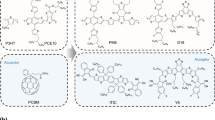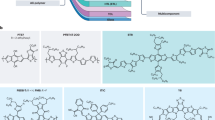Abstract
Solution-processed photovoltaics offer a cost-effective path to harvesting the abundant resource that is solar energy. The organic and polymer semiconductors at the heart of these devices generally absorb only visible light; however, half of the Sun's power reaching the Earth's surface lies in the infrared. Flexible solar cells that harvest wavelengths beyond 1 μm were first reported in 2005. In three years they have increased over 10,000-fold in power conversion efficiency. The latest devices achieve power conversion efficiencies in the infrared of more than 4%, values comparable to those of their organic and polymer counterparts in the visible. Here we review the progress and prospects for the field, focusing on new insights into how quantum-dot solar cells operate and how these findings give guidance on optimizing these devices to their full performance potential.
This is a preview of subscription content, access via your institution
Access options
Subscribe to this journal
Receive 12 print issues and online access
$209.00 per year
only $17.42 per issue
Buy this article
- Purchase on Springer Link
- Instant access to full article PDF
Prices may be subject to local taxes which are calculated during checkout






Similar content being viewed by others
References
Schurig, D. et al. Metamaterial electromagnetic cloak at microwave frequencies. Science 314, 977–980 (2006).
Min, B. et al. High-Q surface-plasmon-polariton whispering-gallery microcavity. Nature 457, 455–458 (2009).
Nelson, J. in Physics of Solar Cells 450 (World Scientific, 2003).
King, R. R. Multijunction cells: Record breakers. Nature Photon. 2, 284–286 (2008).
Green, M. A., Emery, K., Hishikawa, Y. & Warta, W. Solar cell efficiency tables (Version 33). Prog. Photovolt. Res. Applic. 17, 85–94 (2009).
Shah, A., Torres, P., Tscharner, R., Wyrsch, N. & Keppner, H. Photovoltaic technology: The case for thin-film solar cells. Science 285, 692–698 (1999).
Klem, E. J. D., MacNeil, D. D., Cyr, P. W., Levina, L. & Sargent, E. H. Efficient solution-processed infrared photovoltaic cells: Planarized all-inorganic bulk heterojunction devices via inter-quantum-dot bridging during growth from solution. Appl. Phys. Lett. 90, 183113 (2007).
Johnston, K. W. et al. Schottky-quantum dot photovoltaics for efficient infrared power conversion. Appl. Phys. Lett. 92, 151115 (2008).
Koleilat, G. et al. Efficient, stable infrared photovoltaics based on solution-cast colloidal quantum dots. ACS Nano 2, 833–840 (2008).
Luther, J. M. et al. Schottky solar cells based on colloidal nanocrystal films. Nano Lett. 8, 3488 (2008).
Klem, E. J. D., MacNeil, D. D., Levina, L. & Sargent, E. H. Solution processed photovoltaic devices with 2% infrared monochromatic power conversion efficiency: Performance optimization and oxide formation. Adv. Mater. 20, 3433–3439 (2008).
Winder, C. & Sariciftci, N. S. Low bandgap polymers for photon harvesting in bulk heterojunction solar cells. J. Mater. Chem. 14, 1077–1086 (2004).
Johnston, K. W. et al. Efficient Schottky-quantum-dot photovoltaics: The roles of depletion, drift, and diffusion. Appl. Phys. Lett. 92, 122111 (2008).
Clifford, J. P., Johnston, K. W., Levina, L. & Sargent, E. H. Schottky barriers to colloidal quantum dot films. Appl. Phys. Lett. 91, 253117 (2007).
Coakley, K. M. & McGehee, M. D. Conjugated polymer photovoltaic cells. Chem. Mater. 16, 4533–4542 (2004).
Clifford, J. P. et al. Fast, sensitive and spectrally tuneable colloidal-quantum-dot photodetectors. Nature Nanotech. 4, 40–44 (2009).
Blom, P. W. M., Mihailetchi, V. D., Koster, L. J. A. & Markov, D. E. Device physics of polymer: Fullerene bulk heterojunction solar cells. Adv. Mater. 19, 1551–1566 (2007).
Halls, J. J. M. et al. Efficient photodiodes from interpenetrating polymer networks. Nature 376, 498–500 (1995).
Yu, G., Gao, J., Hummelen, J. C., Wudl, F. & Heeger, A. J. Polymer photovoltaic cells: Enhanced efficiencies via a network of internal donor–acceptor heterojunctions. Science 270, 1789–1791 (1995).
O'Regan, B. & Grätzel, M. A low-cost, high-efficiency solar cell based on dye-sensitized colloidal TiO2 films. Nature 353, 737–740 (1991).
Konstantatos, G. et al. Ultrasensitive solution-cast quantum dot photodetectors. Nature 442, 180–183 (2006).
Hoogland, S. et al. Megahertz-frequency large-area optical modulators at 1.55 μm based on solution-cast colloidal quantum dots. Opt. Express 16, 6683–6691 (2008).
Dadosh, T. et al. Measurement of the conductance of single conjugated molecules. Nature 436, 677–680 (2005).
Talapin, D. V. & Murray, C. B. Applied physics: PbSe nanocrystal solids for n- and p-channel thin film field-effect transistors. Science 310, 86–89 (2005).
Barkhouse, D. A. R., Pattantyus-Abraham, A. G., Levina, L. & Sargent, E. H. Thiols passivate recombination centers in colloidal quantum dots leading to enhanced photovoltaic device efficiency. ACS Nano 2, 2356–2362 (2008).
Koleilat, G. I. et al. Efficient, stable infrared photovoltaics based on solution-cast colloidal quantum dots. ACS Nano 2, 833–840 (2008).
Luther, J. M. et al. Structural, optical, and electrical properties of self-assembled films of PbSe nanocrystals treated with 1,2-ethanedithiol. ACS Nano 2, 271–280 (2008).
Westenhoff, S. et al. Charge recombination in organic photovoltaic devices with high open-circuit voltages. J. Am. Chem. Soc. 130, 13653–13658 (2008).
Konstantatos, G., Levina, L., Fischer, A. & Sargent, E. H. Engineering the temporal response of photoconductive photodetectors via selective introduction of surface trap states. Nano Lett. 8, 1446–1450 (2008).
Lee, H. J. et al. CdSe quantum dot-sensitized solar cells exceeding efficiency 1% at full-Sun intensity. J. Phys. Chem. C 112, 11600–11608 (2008).
Hyun, B. et al. Electron injection from colloidal PbS quantum dots into titanium dioxide nanoparticles. ACS Nano 2, 2206–2212 (2008).
Nozik, A. J. Multiple exciton generation in semiconductor quantum dots. Chem. Phys. Lett. 457, 3–11 (2008).
Klimov, V. I. Detailed-balance power conversion limits of nanocrystal-quantum-dot solar cells in the presence of carrier multiplication. Appl. Phys. Lett. 89, 123118 (2006).
Ellingson, R. J. et al. Highly efficient multiple exciton generation in colloidal PbSe and PbS quantum dots. Nano Lett. 5, 865–871 (2005).
Murphy, J. E. et al. PbTe colloidal nanocrystals: Synthesis, characterization, and multiple exciton generation. J. Am. Chem. Soc. 128, 3241–3247 (2006).
Schaller, R. D., Sykora, M., Jeong, S. & Klimov, V. I. High-efficiency carrier multiplication and ultrafast charge separation in semiconductor nanocrystals studied via time-resolved photoluminescence. J. Phys. Chem. B 110, 25332–25338 (2006).
Beard, M. C. et al. Multiple exciton generation in colloidal silicon nanocrystals. Nano Lett. 7, 2506–2512 (2007).
Smith, A. & Dutton, D. Behavior of lead sulfide photocells in the ultraviolet. J. Opt. Soc. Am. 48, 1007 (1958).
Law, M. et al. Structural, optical, and electrical properties of PbSe nanocrystal solids treated thermally or with simple amines. J. Am. Chem. Soc. 130, 5974–5985 (2008).
Luque, A., Martí, A. & Nozik, A. J. Solar cells based on quantum dots: Multiple exciton generation and intermediate bands. MRS Bull. 32, 236–241 (2007).
Jiang, X. et al. PbSe nanocrystal/conducting polymer solar cells with an infrared response to 2 micron. J. Mater. Res. 22, 2204–2210 (2007).
Law, M. et al. Determining the internal quantum efficiency of PbSe nanocrystal solar cells with the aid of an optical model. Nano Lett. 8, 3904 (2008).
Beard, M. C. et al. Variations in the quantum efficiency of multiple exciton generation for a series of chemically treated PbSe nanocrystal films. Nano Lett. 9, 836–845 (2009).
Wang, X. et al. Infrared photocurrent spectral response from plastic solar cell with low-band-gap polyfluorene and fullerene derivative. Appl. Phys. Lett. 85, 5081–5083 (2004).
Mcdonald, S. A. et al. Solution-processed PbS quantum dot infrared photodetectors and photovoltaics. Nature Mater. 4, 138–142 (2005).
Wang, X. et al. Enhanced photocurrent spectral response in low-bandgap polyfluorene and C70-derivative-based solar cells. Adv. Funct. Mater. 15, 1665–1670 (2005).
Zhang, S., Cyr, P. W., McDonald, S. A., Konstantatos, G. & Sargent, E. H. Enhanced infrared photovoltaic efficiency in PbS nanocrystal/semiconducting polymer composites: 600-fold increase in maximum power output via control of the ligand barrier. Appl. Phys. Lett. 87, 1–3 (2005).
Maria, A., Cyr, P. W., Klem, E. J. D., Levina, L. & Sargent, E. H. Solution-processed infrared photovoltaic devices with >10% monochromatic internal quantum efficiency. Appl. Phys. Lett. 87, 1–3 (2005).
Wienk, M. M., Turbiez, M. G. R., Struijk, M. P., Fonrodona, M. & Janssen, R. A. J. Low-band gap poly(di-2-thienylthienopyrazine):fullerene solar cells. Appl. Phys. Lett. 88, 153511 (2006).
Gunes, S. et al. Hybrid solar cells using PbS nanoparticles. Solar Energy Mater. Solar Cells 91, 420–423 (2007).
Sun, M. et al. Near-infrared response photovoltaic device based on novel narrow band gap small molecule and PCBM fabricated by solution processing. Solar Energy Mater. Solar Cells 91, 1681–1687 (2007).
Dissanayake, D. M. N. M. et al. A PbS nanocrystal–C60 photovoltaic device for infrared light harvesting. Appl. Phys. Lett. 91, 133506 (2007).
Perzon, E. et al. A conjugated polymer for near infrared optoelectronic applications. Adv. Mater. 19, 3308–3311 (2007).
Henry, C. H. Limiting efficiencies of ideal single and multiple energy gap terrestrial solar cells. J. Appl. Phys. 51, 4494–4500 (1980).
Acknowledgements
I thank S. Hinds for producing the spatial band diagrams of Fig. 4.
Author information
Authors and Affiliations
Rights and permissions
About this article
Cite this article
Sargent, E. Infrared photovoltaics made by solution processing. Nature Photon 3, 325–331 (2009). https://doi.org/10.1038/nphoton.2009.89
Issue Date:
DOI: https://doi.org/10.1038/nphoton.2009.89
This article is cited by
-
Thin highly transparent visible/near-infrared Ta-doped TiO2 electrode
Journal of Materials Science: Materials in Electronics (2023)
-
Giant mid-IR resonant coupling to molecular vibrations in sub-nm gaps of plasmonic multilayer metafilms
Light: Science & Applications (2022)
-
Intercalated doxorubicin acting as stimulator of PbS photocathode for probing DNA–protein interactions
Microchimica Acta (2021)
-
Ultra High-efficiency Integrated Mid Infrared to Visible Up-conversion System
Scientific Reports (2020)
-
Solution-processed upconversion photodetectors based on quantum dots
Nature Electronics (2020)



